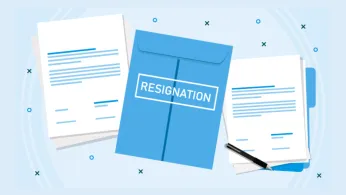On this page
As a sales professional, you have enough on your plate. But without proper deal-closing sales negotiation techniques, you might lose a prospect on the verge of saying yes. In this guide, we share expert sales negotiation techniques, essential sales negotiation phrases, and a comprehensive sales negotiation conversation example—all designed to help you seal the deal and handle negotiations like a pro.
A mere 30% of sales qualified leads are closed by the top businesses, while others hover around the 20% range. Moreover, 80% of prospects say they resisted a deal four times before finally saying “yes,” while 92% of sales professionals give up after hearing “no” just four times.
How do you negotiate a sale? Closing a deal is no walk in the park—it requires patience, persistence, and advanced sales negotiation skills. You might think the prospect isn’t interested, but with the right sales negotiation phrases and techniques, there’s still a strong chance to close the deal. You’ve worked day and night to reach this point, so giving up now is not an option.
Even the most experienced salespeople feel the pressure when deal-closing time arrives. However, you can transform that pressure into a decisive advantage with proven sales negotiation techniques and a solid sales negotiation conversation example.
Closing the deal: New-age sales negotiation techniques that professionals must try
The modern sales landscape calls for new sales closing techniques. And here, we bring you exactly this. With the rise of inbound sales and the shedding of techniques that are commonly seen as too “salesy,” these new-age techniques that take into account the modern customer will come to your aid at every point in the sales cycle and not just the moment of the final purchase.
Through the sales engagement course, you - the salesperson - must keep track of the potential customer's discovered needs and speak to those needs in subsequent interactions. Ensuring that you record these needs will also serve to close deals faster and better. Megan Dunn, Lever’s Megan Dunn, says personalization is key.
The assumptive close
This deal-closing technique takes advantage of positive thinking, which helps you channel your inner confidence into every interaction with your prospect. It emphasizes your belief that the current prospect will close the deal with you from your first outreach to them.
This can astound your interactions with the prospect, making it more confident, authoritative, and well-directed from the get-go!
The question close
The question close is an effective strategy to instill confidence in your prospect while probing further if the prospect isn’t convinced yet. You can find out if any objections arise by asking if they are satisfied with your solution.
If they say yes, then you know you have nailed it. But if their response is a no, throw another question to investigate further, such as ‘May I know why we cannot proceed on this path?’.
This shows you care and you are still interested in providing a solution. It gives you the time to address their objections. Brian Tracy, author, and CEO of Brian Tracy International, says simply asking ‘why won’t you give the product/service a try’ is an effective closing technique.
The soft close
Simply asking if selling aligns with their business’s vision can help you learn more about your prospect. If you want to keep the conversation light yet know more about their needs, you can ask them whether the solution aligns well with their current business goals.
Julianne Gsell, the enterprise sales director of Box.com, can help you build a relationship with them while not throwing anything unexpected their way. You can outline the benefits of what you are selling, but as you aren’t asking them to commit, they are more likely to show interest.
The take away close
This closing technique is based on negotiation. Let us say your prospect is asking for a discount. Rather than saying yes, you can offer to remove certain (unneeded) parts of the solution. This technique is a psychological one because they might not need that part of the solution anyway, so they think they struck gold.
They will likely take up the offer, especially if they object due to the price. This technique works wonders when you have a multi-tiered platform, and removing certain parts and features is possible.
Closing the deal: Tried and tested sales negotiation strategies that haven’t lost their charm
While modern sales negotiation strategies might be the rage now, some traditional techniques are still being used by sales leaders worldwide. They worked then, and they work now, provided you know the right situation to use them in.
The now or never close
Your prospect will be interested in what you have to say if you convince them of an instant reward if they sign on the dotted line immediately. An example of a now or never close would be ‘If you purchase the solution today, you instantly become eligible for a flat 10% discount’. You want to make your prospect unable to resist your offer.
The sense of urgency can convince even the most challenging prospects because they must decide now. Otherwise, the deal will slip away from their hands. This technique works best when you know the prospect is interested in buying but isn’t giving their final nod.
The summary close
In this close technique, you want to clarify why your solution is of value. Reiterating the product features is one thing but showing how the solution can provide high value is even more important.
The summary close makes it clear in your prospect’s mind what they are getting out of the deal. Jill Konrath, author, and speaker, says it works. You can run through the points you discussed earlier in your conversation with your prospect, and this sets them up as they visualize that solution in their life.
This can help motivate them to close the deal. They can get convinced faster when they hear all the reasons why your solution is beneficial. This can help nudge them to decide and say yes to your deal.
The sharp angle close
The sharp angle close can be a win-win situation if you play your cards right. But yes, it requires preparation from your end. Your prospects know they are powerful; the ball is in their court because they need to sign. You can still outsmart them by attaching a condition while agreeing to their negotiation.
For example, let us say your prospect is asking for an add-on. You can say yes and then present a new condition to signing the contract within a stipulated time. You can make them happy by catching them off-guard while closing the deal on the same day.
Advanced sales negotiation skills used by experts
Sales are challenging, but if your prospect asks for negotiation, it can get more complicated unless you are armed with some sales negotiation skills that sales leaders use. Here are some sales negotiation techniques to help you negotiate without losing out.
1. Make them feel heard by paying attention to what they say
Raymond Gunn, the managing partner at Wingspan Capital partners, recommends being the best listener to win. Jill Angelone, Lyft Corporate Travel Emerging Markets account executive, agrees that sometimes being quiet is the best, they talk.
You can convince the prospect if you make them feel heard. The negotiation will be a disaster if you cut them mid-sentence or start countering what they say before they complete what they need to say.
Instead, show respect and let them ultimately say what they need to before starting your counter-argument. This gives you time to think of the negotiation and gives you more perspective on how you want the negotiation to proceed. Moreover, if you speak too early, you might give more than they were going to demand.
2. Responding isn’t equal to reaction.
The two terms are different, but they can make a world of difference in negotiation.
A reaction won’t get you far because you will say whatever comes to mind in the spur of the moment. Expert negotiators don’t let their prospects slip away so easily. Instead, try and slow down the conversation by responding to what your prospect is saying.
You want to take time before responding rather than blatantly refusing what they are saying. This gives you time to negotiate better, so both of you win instead of infusing your conversation with bitterness.
3. Lean towards a level playing field
The negotiation should be mutually beneficial.
You don’t want to make your prospect feel dejected at the end of the negotiation. You want them to feel like they got the best deal possible. But you don’t want to lose out either. If they demand something, put something on the table from your side, such as a request.
When you show that you have heard them and are considering what they are proposing, you show them that you care about them benefitting too. You want it to make it seem like you are considering something because of what they have said.
4. Be prepared because your prospects will ask for discounts
Your prospects know you are expecting them to ask for a discount. You don’t always need to give a discount when your prospect asks you to. But you can give them other benefits rather than decreasing the price of the solution you are selling.
For instance, let us say they ask for a discount because they think your solution isn’t worth the full price. You can show your prospect how the item you are selling is of high value. Rather than transactional talk, you can steer it to value conversation, which can help you get a better deal while offering something in exchange, so your prospect doesn’t seem like they lost.
5. Don’t rush the sales negotiation process.
Negotiations don’t end in one go, so be prepared for the battle.
As a salesperson, you will find it ideal for negotiating the terms and calling it a day. It can take some time in real life, maybe even weeks, before both of you agree on the terms. Before that, don’t rush to change the contract.
Not everything from the prospect will make sense, and some ideas can even seem preposterous. You want to verbally agree on mutual terms before it comes to revising the contract and making changes. The result should be mutually acceptable before closing the deal.
Not all deals close, and while that’s a dismal reality in sales, it doesn’t mean you shouldn’t try strategies to close the deal. Sometimes, it is best to walk away if you are running around in circles with negotiations. But at other times, it is best to give people time, according to Steli Efti, CEO of Close.io, because following up can show you care, and they might convert.
Turbo-charge your teams and channel partners. Compass drives performance and revenue of sales, channel, delivery, and back-office by aligning behaviors with company goals. Want to know more? Book a demo now.
100 Unique sales negotiation phrases to crack sales deals
Here are 100 different sales negotiation strategies to make it easy for you under other conditions. So, let's dive in and explore the world of sales negotiation!
Condition 1: Understand the other party's perspective and rationale to negotiate a better deal.
10 best sales negotiation phrases to satisfy this condition
- Can you tell me more about why you see things that way?
- I'd like to understand your reasoning behind that proposal.
- Help me see your perspective on this issue.
- What factors do you think are most important in this negotiation?
- I'm interested in learning more about your thoughts on this matter.
- Can you walk me through how you arrived at that conclusion?
- Let's explore the reasoning behind each of our positions.
- I'm trying to see things from your point of view. Can you explain it to me?
- What underlying interests do you have that are driving your position?
- Can you provide more context for your stance on this matter?
Condition 2: You need both parties to consider different options and work towards a solution that meets everyone's needs.
10 best sales negotiation phrases to satisfy this condition
- Have you considered a different approach to this issue?
- Let's brainstorm some alternative solutions to explore.
- How open are you to exploring new ideas or perspectives on this matter?
- I have an idea that may be worth considering. Are you interested in hearing it?
- Let's find a mutually beneficial solution that addresses both of our needs.
- Are you open to exploring some creative solutions to this problem?
- Let's consider some out-of-the-box solutions to this issue. What do you think?
- Let's approach this negotiation with an open mind and be willing to consider different options.
- Along with this possibility, let's explore some other possibilities.
- I propose something that may work for both of us. Can we discuss it?
Condition 3: Demonstrate your willingness to compromise and work together for a mutually beneficial outcome.
10 best sales negotiation phrases to satisfy this condition
- I understand your position and am willing to find a compromise that works for both of us.
- Let's work together to find a solution that addresses our concerns.
- I'm eager to make some concessions if we can reach a mutually beneficial agreement.
- Can we find a middle ground that satisfies both of our needs?
- I'm sure, we can find a way to work together and find a solution that works for both parties.
- Let's explore options to reach a compromise we can both live with.
- We can both make some adjustments to our positions and find a solution that meets our respective goals.
- I think, we must find a way to work together to reach an agreement.
- I'm open to finding a solution that may be challenging but is acceptable to both.
- Let's take a collaborative approach and work towards a solution that benefits both parties.
Condition 4: By acknowledging the other party's concerns, you show empathy and a willingness to listen to build trust and help you uncover what's important to them.
10 best sales negotiation phrases to satisfy this condition
- I hear your concerns and want to ensure we address them in our negotiation.
- You have some valid concerns that need to be taken into consideration.
- Let's take some time to discuss your concerns to understand your perspective better.
- I know why this issue is important to you, and I want to find a solution that addresses your concerns.
- Your concerns are valid, and I appreciate you bringing them to my attention.
- Let's work together to find a solution that meets our needs and addresses your concerns.
- I want to find a solution that addresses your concerns while meeting our objectives.
- Can you tell me more about your problems and why they are important to you?
- Let's explore some options to alleviate your concerns while meeting our goals.
- I value your input and want to ensure we address your problems in our negotiation.
Condition 5: You want to focus on the shared goals or interests, which can help align both parties and facilitate a successful negotiation.
10 best sales negotiation phrases to satisfy this condition
- Let's start by focusing on our shared goals and how we can work together to achieve them.
- Our shared interests brought us to the table, so let's keep them in mind as we negotiate.
- We can find a solution that meets our interests and helps us achieve our shared goals.
- Our goals may differ, but we can find common ground that benefits both parties.
- Can we agree on some shared objectives that will guide our negotiation?
- Let's work towards a solution that benefits us individually and helps us achieve our shared goals.
- If we focus on our shared interests, we can find a solution that works for both parties.
- Let's take a moment to identify our shared goals and work together to find a way to achieve them.
- We both have something to gain from this negotiation, so let's focus on finding a solution that benefits us both.
- We can reach a successful agreement if we align our shared interests and objectives.
Condition 6: Clarify the other party's position and ensure you're both on the same page to prevent misunderstanding and negotiate more effectively.
10 best sales negotiation phrases to satisfy this condition
- Please explain your position in more detail so I can better understand where you're coming from.
- I want to understand your perspective before proceeding any further.
- Let me repeat back what I'm hearing to make sure I have a clear understanding of your position.
- Correct me if I'm wrong, but it sounds like you're saying that...
- Let's clarify your position so we're both on the same page and can negotiate more effectively.
- I don't want to assume anything about your position, so please correct me if I need clarification.
- We must clearly understand each other's positions to ensure a successful negotiation.
- Before we proceed, let's take a moment to clarify any misunderstandings and make sure we're aligned on each other's positions.
- Let's start by sharing our positions to understand each other's perspectives and negotiate more effectively.
- Clarifying your position will help me understand your needs and goals, which is critical for finding a mutually beneficial solution.
Condition 7: Build trust and encourage the other party to collaborate with you by expressing confidence in finding a solution together.
10 best sales negotiation phrases to satisfy this condition
- We can find a solution that meets our needs if we work together.
- Let's approach this negotiation with a positive attitude and a belief that we can find a way to reach an agreement.
- I'm optimistic that we can come to a mutually beneficial solution if we collaborate and work together.
- I look forward to working with you to find a solution that meets our needs.
- By working together, we can find a better solution than we could have come up with.
- Let's focus on finding a win-win solution that benefits both parties, and I'm confident we can get there together.
- I'm excited about the possibilities of working together to find a solution that meets our objectives.
- I'm committed to working collaboratively to find a solution that meets our needs.
- Let's explore different options together and find a solution for everyone involved.
- By working together, I'm confident we can overcome obstacles and find a solution that satisfies both parties.
Condition 8: By acknowledging the other party's perspective and offering an alternative viewpoint, you can help shift the conversation towards a more collaborative and creative negotiation.
10 best sales negotiation phrases to satisfy this condition
- I appreciate your perspective, and I'd like to offer a different viewpoint that may help us find a mutually beneficial solution.
- I understand where you're coming from, but I'd like to present another way of looking at the situation.
- While I see your point, there may be another approach that could work better for both parties.
- Let's explore both perspectives and find a way to merge them into a more creative solution.
- Your perspective is critical, and I'd like to add to the conversation by presenting an alternative viewpoint.
- While we may not agree for everything, we can find a solution that benefits both parties by considering each other's perspectives.
- I respect your position, and there may be another option that we haven't considered yet.
- Let's brainstorm and find a way to combine our perspectives into a more innovative solution.
- Acknowledging your perspective is important, but I also want to offer another way of thinking about the situation.
- By considering both perspectives, we can expand our thinking and develop a more creative solution that benefits everyone.
Condition 9: You must crack this deal when the price exceeds the client's budget.
10 best sales negotiation phrases to satisfy this condition
- We understand the price may exceed your budget, but our product/service is worth the investment.
- Let's work together to explore some options to help you stretch your budget and make this deal happen.
- We're committed to delivering value to our clients, and we're confident that our product/service will help you to achieve your goals.
- We're willing to be flexible on some terms and conditions to help make this deal work for you.
- Let's talk about the potential ROI of our product/service and how it can help you to achieve your business objectives.
- We have some financing options that will help you manage the cost of this deal.
- I understand that cost is a critical factor, but let's also consider the long-term benefits of our product/service to your business.
- I'm willing to offer additional services or features to sweeten the deal and make it more appealing.
- Let's discuss some creative solutions that can help to bridge the gap between our price and your budget.
- This deal is a win-win for both of us, and we're committed to working with you to find a way to make it happen.
Condition 10: You need to make the sales, but these are the customers you can't afford to lose.
10 best sales negotiation phrases to satisfy this condition
- We highly value your business and want to ensure that we continue providing you with the best possible service and products.
- I understand that there are other options available, but my offering is the best fit for your needs.
- We're willing to work with you to find a solution that meets our needs and allows us to continue our successful partnership.
- Let's explore some options together and see how we can make this work for both of us.
- We know that your business is critical to our success, and we want to ensure that we are doing everything possible to meet your expectations.
- We're willing to be flexible and make some concessions to ensure we can continue serving you.
- We've some new products and services that could be an excellent fit for your business, and we'd love to discuss them with you.
- We value our relationship with you and are committed to finding a solution that keeps you as a valued customer.
- Let us review your needs and see if we can better meet them to ensure your satisfaction.
- We're committed to delivering exceptional customer service and products. We want to ensure that we exceed your expectations.
Conclusion
Mastering sales negotiation techniques is essential for closing deals with confidence. The right sales negotiation phrases can help you steer conversations in your favor, address objections, and create win-win situations for both you and your prospects.
By applying the techniques covered in this guide and learning from each sales negotiation conversation example, you’ll improve your ability to handle tough negotiations and increase your success rate. With preparation, patience, and the right approach, you can turn hesitant prospects into loyal customers and achieve better sales outcomes.














